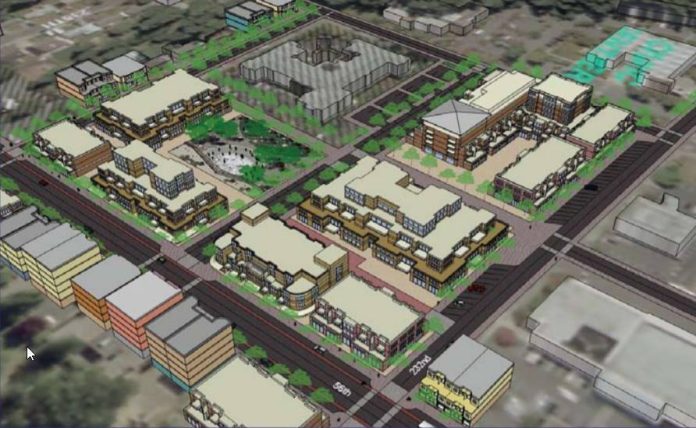The City of Mountlake Terrace is working through a subarea planning process to update the city’s “town center” as light rail begins its reach to the community. The area was first designated in 2008 as part of a planned action ordinance. Work to update the subarea, however, would in some ways expand the boundaries of the town center and supersede existing zoning.

The central area of the town center in focus is an area north of 237th St SW, south of 230th St SW, and west of 55th Ave W. Mountlake Terrace Station for its part will be located near 236th St SW at I-5. The town center core area, therefore, is planned to emanate within a 10-minute walk of the station.
Blocks closest to the light rail station would be rezoned to District 1, which would allow buildings ranging from six to 12 stories. Current zoning in those areas either comprise single-family zoning or considerably more modest heights of five stories or less. Realistically, the city will have to hope that cross-laminated timber helps development reach those heights, though six-over-two building provisions could help, too. In the traditional town center, new districts would also be created allowing building heights to range from four to eight stories.

The subarea plan had envisioned a notch east of 55th Ave W earlier on. However, in December, staff agreed to remove the notch of District 3 zoning north of 232nd St SW. Those properties are already developed with commercial uses. Areas beyond the town center boundary would act as transitional zones, a buffer to single-family areas.
The draft subarea plan describes the intent of the three zoning districts as follows:
- District 1 will primarily provide professional office space. Retail, restaurants, lodging, and other service uses are complementary with ground floors of buildings containing active uses. Multifamily is allowed as part of mixed use, but standalone multifamily is expected to be limited.
- District 2 is expected to be mixed-use with active ground floor uses. Standalone multifamily is expected on non-retail block frontages.
- District 3 is expected to primarily consist of standalone multifamily development, though ground floor retail is encouraged at key intersections and along 56th Ave W.

The city intends to create design standards that are tied to the frontage designation type. Landscaped frontages will encourage heavier landscaping areas near the front of buildings and residential stoops to soften them in respect to single-family areas. Secondary frontages could match that of landscaped frontages or storefront frontages.
As the town center builds out, Mountlake Terrace hopes to construct a new north-south public street between 58th Ave W and 56th Ave W and new east-west public street between 232nd St SW and 230th St SW. This would create a relatively small block network. A new pathway would also extend from the western terminus of 235th St SW to the transit center.
The city planning commission is still in the process of reviewing the town center subarea plan, which should result in clearer regulatory changes, such as design standards, bulk regulations, parking requirements, landscaping standards, and incentives. The city is also consider implementation of a new Multi-Family Tax Exemption program and categorical exemption of projects in the town center from the State Environmental Policy Act. The latter could streamline approval processes for projects and speed up permitting.
In March, a public hearing on the subarea plan is expected before the planning commission. A recommendation could come thereafter and a final subarea plan could be adopted later this year.
Stephen is a professional urban planner in Puget Sound with a passion for sustainable, livable, and diverse cities. He is especially interested in how policies, regulations, and programs can promote positive outcomes for communities. With stints in great cities like Bellingham and Cork, Stephen currently lives in Seattle. He primarily covers land use and transportation issues and has been with The Urbanist since 2014.


